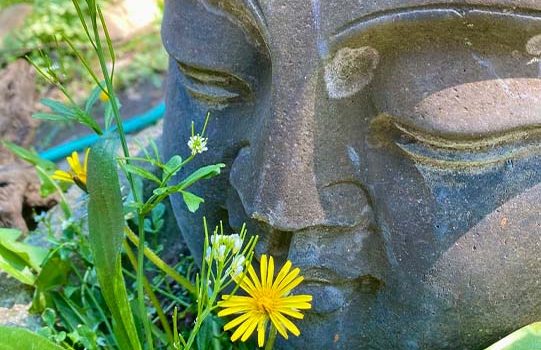Accepting life's gifts by surrendering to what life is presenting to you and creating from there. The call and response of life.
The Map Is Not The Territory

The map is not the territory” is a phrase first coined by Alfred Korzybski (1931) to reflect that the abstraction of something is not to be confused with the thing itself, or that models of reality are often mistaken for reality itself. In Plato’s cave metaphor, where people living in a cave misinterpreted the shadows on the cave walls with reality, one is mistaking something else for the true experience. Alan Watts referred to this concept as confusing the menu with the meal. You can read about a dish you would like to eat, and you can drool over the ingredients in anticipation, but it is only in the tasting that you have the experience that becomes the knowing.
Spiritual experiences can also lead to biased interpretations of experiences. What do I mean by this? If you have been taught a concept, of any kind, related to God, gods, or anything that frames a numinous experience when you have it, then you may preferentially categorize the experience within a spiritual interpretation. For example, you may proclaim that you had an experience of God, Jesus, or Ganesha coming and removing all your obstacles. Interpretations are made through preexisting concepts and ideas – “the map”. An overreliance on the map may blind us from awareness of the territory. Categorizing and engaging the analytical mind to put what is experienced into a contextual understanding too soon, can separate you from your experience. The invitation is to stay in the experience without naming, categorizing, and attaching to the “thing”. It is not the thing. It is experiencing one’s being in the world in a new and different way – expanded perceptions and beyond the known. The territory is the unknown.
Practicing the art of presence, equanimity, and being mindful of your attributions to things, helps you remain open to the territory beyond your map. The mind is absolutely amazing. It works at hyper-speeds in identifying, categorizing, and responding to information from the external world and interfacing with our early experiences, instincts, and ancestral blueprints. The speed is so rapid it can be overwhelming to follow as we travel on the roads of our attachments and aversions. It is difficult to just watch and maintain an open internal awareness without bias. We can improve with the practice of increased awareness, consciousness, of waking up, or becoming more alive and self-sovereign.
Now back to “The map is not the territory.” Here’s how I see it. You are not the map – you are the territory. You are not your body. You are your being. Your being is a wave form. Your body is a point of manifestation. Your body is electric. Your being is acoustic. Your “beingness” comprises your consciousness and can expand` far and as wide. It is ever evolving. The Sanskrit chant, “Gate, gate, paragate, para sum gate, bodhi svaha”, literally means “Gone, gone, gone utterly beyond, enlightenment, hail.” Consciousness expands beyond consciousness itself.
The body is anchoring this multidimensional being of consciousness. I like to imagine the roads on the map as the neuron-pathways in our brain. Pathways that are filled with connections and electrical firings that wire the whole brain. These pathways like roads, are the physical connection to our responses. The more they are used the deeper the grooves. There is a saying coined by neuropsychologist Donald Hebb, “Neurons that fire together wire together”.” The more you use a neural circuit, the stronger it becomes. Similarly, the older and more habitual the ways of thinking, feeling, and responding are, the quicker our reactions. Hence, we have less pause, less ability to observe and less ability to reflectively respond.
Habitual ways of thinking become our mind maps. Like highways, busy thorough
fares and arterial streets they are the most used. Highways are our well-trodden neuron-pathways, our habits. These habits of thinking, feeling, and acting can be like “frames” or lenses through which we see the world. When they are deeply entrenched, to use computer terminology, they may become our chief operating system and may need updating. Habits are difficult to change.
Well-trodden roads are safe, and easily known. We like to know where we are going. It is also our nature. Our mind is a pattern recognition expert solving puzzles and taking the path of least resistance. It is economical. Sometimes curiosity or roadblocks may present circumstances where we need to take a different route. If you enjoy the view and the change of scenery – depending on your openness to the unknown, our curiosity might take you down unknown streets more often. You may be invigorated by new vistas and keep exploring. In doing so you are expanding your map and feeling into the new territory. The map is not the territory. When you pull back from the map itself and increase the field of observation, the map starts to show an expanse of territory that has no roads, and no paths. You may get a sense of the expanse of your being itself and the possibility of so much more.
To trod beyond the concepts of the known, and into the experience of your own knowing.
You are not your thoughts, you are not your habits, you are more than a result of your experiences, conclusions, thoughts, beliefs, and choices. You are both the map and the territory. Create new roads, explore new vistas, let your curiosity expand the beyond the known, beyond your long-held beliefs, conclusions, and ways of knowing the world. Find ways every day to go down a different path. Try a different way home. Catch yourself in a belief that has constrained you and ask yourself, “What else is possible?”


